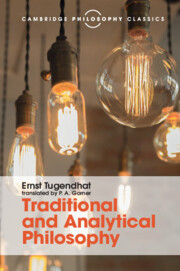Book contents
- Frontmatter
- Dedication
- Contents
- Preface
- Preface
- Translator's preface
- Part I Introduction: confrontation of analytical philosophy with traditional conceptions of philosophy
- Part II A first step: analysis of the predicative sentence
- 8 Preliminary reflections on method and preview of the course of the investigation
- 9 Husserl's theory of meaning
- 10 Collapse of the traditional theory of meaning
- 11 Predicates: the first step in the development of an analytical conception of the meaning of sentences. The dispute between nominalists and conceptualists
- 12 The basic principle of analytical philosophy. The dispute continued. Predicates and quasi-predicates
- 13 The meaning of an expression and the circumstances of its use. Dispute with a behaviouristic conception
- 14 The employment-rule of an assertoric sentence. Argument with Grice and Searle
- 15 Positive account of the employment-rule of assertoric sentences in terms of the truth-relation
- 16 Supplements
- 17 ‘And’ and ‘or’
- 18 General sentences. Resumption of the problem of predicates
- 19 The mode of employment of predicates. Transition to singular terms
- 20 What is it for a sign to stand for an object? The traditional account
- 21 The function of singular terms
- 22 Russell and Strawson
- 23 What is ‘identification’?
- 24 Specification and identification. Specification and truth
- 25 Spatio-temporal identification and the constitution of the object-relation
- 26 Supplements
- 27 Results
- 28 The next steps
- Bibliography
- Index of names
- Index of subjects
15 - Positive account of the employment-rule of assertoric sentences in terms of the truth-relation
from Part II - A first step: analysis of the predicative sentence
Published online by Cambridge University Press: 05 August 2016
- Frontmatter
- Dedication
- Contents
- Preface
- Preface
- Translator's preface
- Part I Introduction: confrontation of analytical philosophy with traditional conceptions of philosophy
- Part II A first step: analysis of the predicative sentence
- 8 Preliminary reflections on method and preview of the course of the investigation
- 9 Husserl's theory of meaning
- 10 Collapse of the traditional theory of meaning
- 11 Predicates: the first step in the development of an analytical conception of the meaning of sentences. The dispute between nominalists and conceptualists
- 12 The basic principle of analytical philosophy. The dispute continued. Predicates and quasi-predicates
- 13 The meaning of an expression and the circumstances of its use. Dispute with a behaviouristic conception
- 14 The employment-rule of an assertoric sentence. Argument with Grice and Searle
- 15 Positive account of the employment-rule of assertoric sentences in terms of the truth-relation
- 16 Supplements
- 17 ‘And’ and ‘or’
- 18 General sentences. Resumption of the problem of predicates
- 19 The mode of employment of predicates. Transition to singular terms
- 20 What is it for a sign to stand for an object? The traditional account
- 21 The function of singular terms
- 22 Russell and Strawson
- 23 What is ‘identification’?
- 24 Specification and identification. Specification and truth
- 25 Spatio-temporal identification and the constitution of the object-relation
- 26 Supplements
- 27 Results
- 28 The next steps
- Bibliography
- Index of names
- Index of subjects
Summary
In the last lecture I started out from the assumption that before we can determine the employment-rules of predicates, and of the singular terms which supplement predicates so as to form elementary assertoric sentences, we must first possess a preliminary conception of the employment-rules, and that means of the meaning, of whole assertoric sentences. We need a reasonably solid conceptual basis for the enquiry into the understanding of the components of an elementary assertoric sentence, even if this basis can itself only be subsequently consolidated by the analysis of the understanding of the components of the predicative sentence.
Even this question of a merely provisional understanding of the employment-rules of assertoric sentences turns out to be exceedingly difficult. I will summarize the results achieved so far:
(1) Already in the lecture before last we were able to exclude the behaviouristic or quasi-behaviouristic conception according to which the employment-rule relates to circumstances, the employment-situation.
(2) Likewise excluded is the object-orientated conception which relates the employment of the sentence to a representation or idea (however this is to be interpreted) of a state of affairs or actual state of affairs; such an explanation would be a hysteron-proteron because the state of affairs can itself only be identified by means of sentences.
(3) It next seemed plausible to interpret the employment-rules as functional rules and to relate them, on the one hand, to the addressee and, on the other hand, to the consequences of the speech-act. But the question was: How? The most natural thing seemed to be to view the act as being defined by an intended effect and the rules as instrumental rules; this conception led to the speech-act being defined as an act of informing. However, the correct statement that someone who, vis-à-vis a partner, utters an assertoric sentence ‘p’ thereby informs him that he believes that p, and that this means that in a specific way he intends to bring it about that the partner believes that he believes that p, also proved to be an unsuitable basis for arriving at the employment-rule of the sentence.
(4) I then suggested, appealing to the illocutionary-act theory, that we should understand the semantically relevant act of employing an assertoric sentence not as an act of communication but as an act of assertion. However, we could find no satisfactory answer in Searle to the question concerning the employment-rules of an assertion.
- Type
- Chapter
- Information
- Traditional and Analytical PhilosophyLectures on the Philosophy of Language, pp. 201 - 215Publisher: Cambridge University PressPrint publication year: 2016



